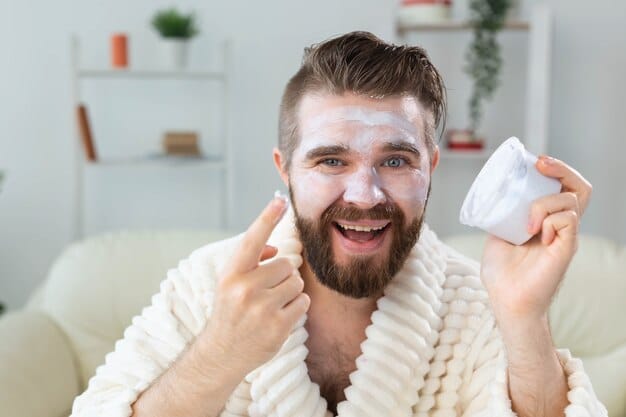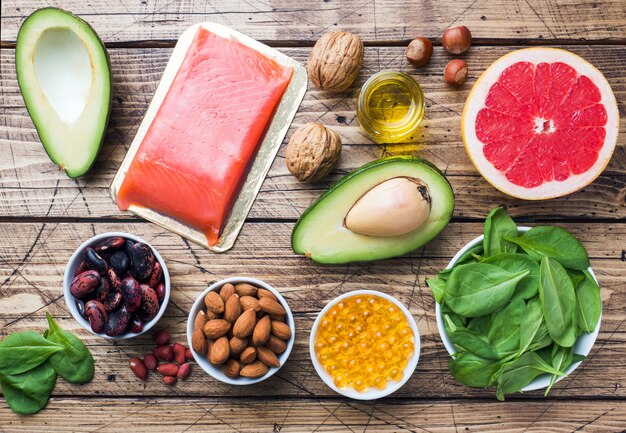Combat Winter Dryness: Updated 3-Step Skincare for Men in 2025

To combat winter dryness, men in January 2025 should adopt an updated 3-step skincare routine focusing on hydration, barrier repair, and SPF, tailored to the harsh conditions to maintain healthy, resilient skin. This approach addresses common cold-weather skin issues effectively.
As January 2025 ushers in the coldest, driest months, men often face a unique set of skincare challenges, particularly when it comes to combating winter dryness. This comprehensive guide outlines The Updated 3-Step Skincare Routine for Men in January 2025, designed to fortify your skin’s defenses against the harsh elements.
Understanding Winter’s Impact on Men’s Skin
The winter season brings significant environmental changes that can profoundly affect male skin, often leading to dryness, irritation, and a compromised skin barrier. Understanding these unique challenges is the first step toward effective mitigation and maintaining skin health.
Cold temperatures, coupled with low humidity both outdoors and indoors (thanks to heating systems), strip the skin of its natural moisture. This leads to a variety of issues, from flakiness and tightness to more severe conditions like eczema flare-ups. Men, often with thicker skin and larger pores, might perceive their skin as more resilient, but it is equally susceptible to winter’s ravages. The continuous cycle of moving from cold, dry outdoor air to warm, dry indoor environments creates a constant assault on the skin’s protective lipid barrier.
The Science Behind Winter Dryness
Our skin naturally produces oils (sebum) that form a protective layer, trapping moisture and defending against external aggressors. In winter, this natural process is hindered. The cold constricts blood vessels, reducing oil production, while the dry air acts like a sponge, pulling moisture directly from the skin. This phenomenon is known as transepidermal water loss (TEWL).
- Reduced Sebum Production: Lower temperatures can signal the sebaceous glands to slow down, decreasing the natural skin oils essential for moisture retention.
- Compromised Skin Barrier: The constant loss of moisture weakens the skin’s lipid barrier, making it more permeable and vulnerable to irritants and allergens.
- Increased Inflammation: Dry, compromised skin is more prone to inflammation, leading to redness, itching, and discomfort.
Moreover, factors unique to men, such as daily shaving, can exacerbate winter dryness. Shaving, especially with harsh products or against the grain, can further strip the skin of its natural oils and create micro-tears, making it even more vulnerable to moisture loss and irritation. Therefore, a targeted approach is crucial, focusing on replenishment and protection, moving beyond generic skincare advice.
Acknowledging these challenges is vital. The goal isn’t just to alleviate symptoms but to build resilience, ensuring your skin remains healthy and comfortable throughout the winter months.
Step 1: Gentle Cleansing and Preparation
The foundation of any effective skincare routine, especially in winter, begins with proper cleansing. For men, this means moving beyond harsh bar soaps or overly stripping cleansers that can exacerbate dryness and disrupt the skin’s delicate moisture balance.
In January 2025, the focus for men’s winter cleansing should be on gentleness and hydration. Over-cleansing or using products with strong sulfates can strip away essential natural oils, leaving skin feeling tight, dry, and vulnerable. The ideal cleanser should remove impurities, excess oil, and pollutants without compromising the skin’s natural barrier. This ensures the skin is clean and prepped, ready to effectively absorb the subsequent hydrating and protective products.
Choosing the Right Cleanser for Your Skin
Selecting a cleanser appropriate for the winter months is paramount. Look for formulations that are gentle yet effective. Cream-based, oil-based, or hydrating gel cleansers are often excellent choices for combating winter dryness, as they are less likely to strip the skin.
- Hydrating Cream Cleansers: These are ideal for dry and sensitive skin types. They cleanse thoroughly while simultaneously infusing moisture, leaving skin soft and comfortable.
- Oil Cleansers: Excellent for dissolving impurities and makeup (if applicable), these cleansers work on the principle of “like dissolves like,” effectively removing oil-based debris without stripping. They often leave a nourishing film on the skin.
- Gentle Gel Cleansers (Sulfate-Free): For those who prefer a traditional “foaming” sensation, ensure the gel cleanser is sulfate-free to avoid harsh drying effects. These can be suitable for normal to combination skin types.
Consider cleansers fortified with ingredients like glycerin, hyaluronic acid, or ceramides, which attract and retain moisture. These ingredients provide an immediate boost of hydration even during the cleansing process. Avoid products containing strong fragrances or harsh exfoliants during this time, as they can further irritate already compromised skin.
The act of cleansing itself should also be gentle. Use lukewarm water rather than hot water, as hot water can further strip skin of its natural oils. Gently massage the cleanser onto your face for about 30-60 seconds, then rinse thoroughly. Pat your face dry with a clean, soft towel instead of rubbing vigorously. This gentle approach sets the stage for a hydrated and protected complexion, ensuring your skin is optimally prepared for the next steps in your winter routine.
Step 2: Intense Hydration and Barrier Repair
Once your skin is clean and prepped, the next crucial step in combating winter dryness is providing intense hydration and focusing on repairing the skin’s natural barrier. This step is about replenishing lost moisture and creating a robust defense against environmental stressors. It’s where the deeper work of preventing and treating winter-induced dryness truly happens, moving beyond superficial relief to genuine skin health.
During winter, the skin’s lipid barrier — composed of fatty acids, cholesterol, and ceramides — can become compromised due to low humidity and cold winds. A weakened barrier allows moisture to escape more easily and irritants to penetrate, leading to dryness, redness, and sensitivity. Therefore, the choice of hydrating products should be strategic, focusing on ingredients that not only add water but also seal it in and fortify the barrier.
Essential Hydrators and Repairing Ingredients
For January 2025, men’s winter skincare routines should heavily feature hydrators and barrier-repairing agents. These are the workhorses that ensure your skin stays supple and protected throughout the harshest months.
- Hyaluronic Acid (HA): A powerful humectant that can hold up to 1,000 times its weight in water, drawing moisture from the air and into the skin. Apply it to damp skin for maximum efficacy. Serums rich in HA are an excellent first layer after cleansing.
- Ceramides: These are lipids that are naturally found in the skin barrier. Replenishing ceramides helps to restore the skin’s natural protective layer, preventing water loss and offering protection from environmental damage. Look for moisturizers or serums containing various types of ceramides.
- Glycerin: Another potent humectant, glycerin works similarly to HA, attracting moisture to the skin. It’s a common and effective ingredient in many hydrating products.
- Niacinamide (Vitamin B3): This versatile ingredient helps improve skin barrier function, reduce redness, and can even out skin tone. It supports ceramide production and has anti-inflammatory properties, making it ideal for irritated winter skin.
- Squalane/Squalene: These emollient ingredients mimic the skin’s natural oils, forming a protective barrier that reduces transepidermal water loss. Squalane is particularly stable and non-comedogenic (non-pore-clogging).
- Shea Butter/Occlusives: For drier skin types or extremely cold conditions, heavier moisturizers or balms containing occlusives like shea butter, petrolatum, or lanolin can create a physical barrier on the skin’s surface, preventing moisture evaporation.
After applying a hydrating serum (like one with hyaluronic acid) to slightly damp skin, follow it up with a rich, nourishing moisturizer. The moisturizer acts as a seal, locking in the hydration from the serum and providing additional barrier support. For men who shave, applying these products immediately after shaving can also help soothe and repair any post-shave irritation, leveraging the skin’s openness to absorb beneficial ingredients.

Incorporating these steps and ingredients ensures that your skin receives deep, lasting hydration and that its natural protective barrier is fortified, preparing it to withstand the drying effects of winter.
Step 3: Protection and Targeted Treatments
The final pillar of your updated winter skincare routine for men in January 2025 is protection and the astute use of targeted treatments. This step ensures that all the effort you put into cleansing and hydrating isn’t undone by environmental factors and that any specific concerns are addressed effectively. Protection isn’t solely about SPF; it encompasses safeguarding your skin from wind, extreme cold, and other daily aggressors. Targeted treatments, meanwhile, offer a tailored approach to specific winter skin woes, from chapped lips to persistent dry patches.
Many men overlook the importance of daily sun protection during winter, mistakenly believing that the sun’s rays are less potent. However, UV radiation is present year-round and can still contribute to skin damage, aging, and even exacerbate dryness by further weakening the skin barrier. Integrating SPF is therefore a non-negotiable part of a comprehensive routine.
Daily Sun Protection and Targeted Care
Even on cloudy winter days, UVA and UVB rays penetrate clouds and reflect off snow, reaching your skin. Regular SPF application is crucial. For this winter, men should opt for a broad-spectrum sunscreen with an SPF of at least 30.
- Moisturizer with SPF: Many brands offer moisturizers that include SPF, streamlining your morning routine. This is a convenient option for daily protection.
- Physical Sunscreens: Formulas containing zinc oxide or titanium dioxide tend to be gentler on sensitive, dry winter skin and provide immediate broad-spectrum protection.
- Reapplication: While daily application is key, remember to reapply more frequently if you’re spending extended time outdoors, especially skiing or snowboarding, where UV exposure is amplified.
Beyond SPF, targeted treatments address specific issues that arise or worsen in winter:
Lip Balm: The lips are particularly vulnerable to chapping and cracking in cold, dry weather. A rich, emollient lip balm with ingredients like shea butter, beeswax, or petrolatum should be applied multiple times a day. Look for formulas with SPF for added protection.
Eye Cream: The delicate skin around the eyes is often the first to show signs of dryness and dehydration. A hydrating eye cream can help prevent fine lines and maintain suppleness in this sensitive area. Apply it gently morning and night.
Exfoliation (Used Sparingly): While regular exfoliation is important for most skin types, it should be approached with extreme caution in winter. Over-exfoliation can strip the skin and compromise the barrier, worsening dryness. If you do exfoliate, opt for a gentle chemical exfoliant (like a low concentration of AHA or BHA) once a week or every other week, rather than harsh physical scrubs. Follow immediately with intense hydration.
Humidifiers: While not a topical treatment, placing a humidifier in your home or office can significantly increase indoor humidity levels, directly counteracting the drying effects of central heating. This helps by adding moisture back into the air, which in turn benefits your skin.
By consistently applying broad-spectrum SPF, addressing specific dry zones with targeted treatments, and creating a more humid indoor environment, you are actively protecting your skin from various winter aggressors. This holistic approach ensures your skin is not only moisturized but also resilient against the elements, maintaining its health and appearance even as temperatures drop.
Addressing Common Winter Skincare Misconceptions for Men
Despite the growing awareness around male grooming, several misconceptions about winter skincare persist among men. Dispelling these myths is crucial for adopting an effective routine and avoiding practices that could inadvertently harm the skin, especially during the harsh conditions of January 2025.
Many men believe that their skin is inherently tougher and therefore less susceptible to environmental stresses like winter dryness than, say, women’s skin. While male skin does tend to be thicker and oilier on average, it is by no means impervious to dehydration and damage. The physiological differences do not grant immunity; they simply alter the manifestation of symptoms or the preferred product textures.
Shedding Light on Persistent Myths
Let’s address some common misunderstandings that can derail a man’s winter skincare efforts:
- Myth 1: “My Skin is Oily, So I Don’t Need Moisturizer in Winter.”
Reality: Even oily skin types can experience dehydration. Oily skin often lacks water, not oil. When skin is dehydrated, it can actually produce more oil to compensate, leading to breakouts and an uncomfortable tight feeling under the oil slick. All skin types benefit from a lightweight, non-comedogenic moisturizer, especially in winter. The key is finding a formula designed for oily skin that provides hydration without adding excess grease.
- Myth 2: “Hot Showers Are Best for Warming Up in Winter.”
Reality: While tempting, long, hot showers and baths strip the skin of its natural oils, further compromising the skin barrier and exacerbating dryness. Lukewarm water is preferable, and shower times should be kept brief. Immediately after, gently pat dry and apply moisturizer to damp skin to lock in hydration.
- Myth 3: “Sunscreen is Only for Summer or Sunny Days.”
Reality: This is perhaps one of the most dangerous myths. UV radiation is present year-round, regardless of temperature or cloud cover. UVA rays, which contribute to aging and skin cancer, penetrate deep into the skin and are largely consistent throughout the year. Snow can also reflect up to 80% of UV rays, significantly increasing exposure. Daily broad-spectrum SPF 30+ is non-negotiable for protecting skin health and preventing winter dryness-induced sensitivity.
- Myth 4: “Shaving Just Scrubs Away Dry Skin – That’s Good, Right?”
Reality: While shaving can lightly exfoliate, it also physically scrapes the skin, potentially irritating a dry or compromised barrier. Using a sharp razor, shaving with the grain, and employing a hydrating shave cream or gel can minimize irritation. Following up immediately with a soothing aftershave balm (alcohol-free) and moisturizer is critical for post-shave repair and hydration.
Challenging these ingrained beliefs is the first step toward a genuinely effective winter skincare routine. By understanding the science behind skin health and adopting practices that support, rather than hinder, your skin’s natural functions, men can navigate the winter months with comfort and confidence.
Beyond the 3 Steps: Lifestyle and Diet for Winter Skin Health
While a targeted 3-step skincare routine forms the core of combating winter dryness for men in January 2025, optimal skin health extends beyond topical applications. A holistic approach that integrates lifestyle adjustments and dietary considerations can significantly amplify the benefits of your skincare products, providing comprehensive protection and nourishment from within. Skin is an organ, and its health reflects overall well-being.
The harsh winter environment places extra demands on the body, and neglecting internal factors can undermine even the most diligent external skincare efforts. Hydration from within, proper nutrition, and mindful habits can contribute to a stronger skin barrier, reduced inflammation, and better overall skin resilience against the cold and dry air.
Internal Support for Robust Skin
To truly fortify your skin against winter’s challenges, consider these internal strategies:
- Hydration from Within (Water Intake):
While topical hydration is vital, sufficient internal hydration is equally crucial. Dehydration within the body can manifest as dry, dull skin. Aim to drink an adequate amount of water throughout the day. Herbal teas or broths can also contribute to fluid intake without the dehydrating effects of excessive caffeine or alcohol. Maintaining proper hydration internally ensures skin cells are plump and functional, supporting the skin’s barrier.
- Balanced Diet Rich in Skin-Boosting Nutrients:
Your diet plays a direct role in skin health. Focus on foods rich in omega-3 fatty acids, antioxidants, and vitamins:
- Omega-3 Fatty Acids: Found in fatty fish (salmon, mackerel), flaxseeds, chia seeds, and walnuts, omega-3s possess anti-inflammatory properties and are essential for maintaining a healthy skin barrier.
- Antioxidants (Vitamins C & E): These combat free radical damage caused by environmental stressors. Vitamin C (citrus fruits, bell peppers, broccoli) is vital for collagen production, while Vitamin E (nuts, seeds, avocados) helps protect cell membranes.
- Zinc: Lean meats, nuts, and legumes are good sources of zinc, which supports wound healing and reduces inflammation.
A diet rich in whole foods, fruits, vegetables, and healthy fats provides the building blocks for resilient and healthy skin.
- Mindful Bathing and Showering Habits:
As mentioned previously, avoid overly hot and prolonged showers. Keep baths and showers brief and use lukewarm water. Immediately after, while your skin is still damp, apply a rich, emollient body moisturizer to seal in moisture. This is especially important for areas like shins and elbows, which are prone to extreme dryness in winter.

Adopting these lifestyle and dietary habits creates a synergistic effect, working in tandem with your topical skincare routine to ensure your skin is not only protected from the outside but also nourished and resilient from the inside. This comprehensive approach is the key to truly combating winter dryness and maintaining healthy, comfortable skin throughout the colder months.
Customizing Your 3-Step Routine for Specific Needs
While the 3-step skincare routine offers a robust framework for combating winter dryness, men’s skin types and specific concerns vary. Therefore, the ultimate effectiveness of this routine in January 2025 lies in its thoughtful customization. Adapting the core steps to suit individual needs ensures that the approach is not only generalized for winter but also optimized for your unique skin profile. This personalized touch transforms a good routine into an exceptional one.
Recognizing your skin type—whether it’s oily, dry, combination, sensitive, or mature—is the first step in this customization. Each type responds differently to products and ingredients, and what works wonders for one might not be ideal for another. Moreover, specific concerns like acne, rosacea, or signs of aging require particular attention, especially when exacerbated by cold, dry conditions.
Tailoring the Routine for Individual Skin Types and Concerns
Here’s how to fine-tune your 3-step routine:
- For Oily/Acne-Prone Skin:
Even oily skin gets dehydrated in winter. Opt for lighter, non-comedogenic formulations. For cleansing, a gentle foaming or gel cleanser with salicylic acid can help manage breakouts without stripping. In Step 2 (Hydration), choose oil-free gel moisturizers or serums rich in hyaluronic acid and niacinamide. In Step 3 (Protection), a lightweight, matte-finish SPF is ideal. Avoid heavy, occlusive balms unless for very specific, localized dry patches.
- For Dry/Sensitive Skin:
Your skin needs maximum hydration and barrier support. For cleansing, a rich cream or oil cleanser is preferred. In Step 2, layer hydrating serums (hyaluronic acid) under thick, emollient moisturizers rich in ceramides, shea butter, and beneficial oils. During Step 3, choose mineral sunscreens (zinc oxide/titanium dioxide) as they are less irritating. Consider incorporating a facial oil as a final step at night for extra nourishment.
- For Combination Skin:
This type often presents a challenge, with oily T-zones and drier cheeks. You might need to use different products or adjust application amounts. A gentle gel cleanser works well. For hydration, a medium-weight moisturizer might suffice, perhaps paired with a hyaluronic acid serum globally, and a targeted heavier cream only on drier areas. SPF should be non-comedogenic but provide adequate moisture. Spot treat with richer products on drier areas, and lighter ones on oilier areas.
- For Mature Skin (Addressing Signs of Aging):
Mature skin tends to be drier and less elastic. Incorporate anti-aging ingredients into your hydrating step. After cleansing, consider a serum with peptides or bakuchiol (a gentler retinol alternative) before your moisturizer. Ensure your moisturizer is rich in ceramides and fatty acids to support barrier function and plump up the skin. SPF is paramount year-round to prevent further photoaging, and a rich eye cream is essential.
- Addressing Specific Concerns (e.g., Rosacea, Eczema):
These conditions require a delicate touch, especially in winter. Consult with a dermatologist for tailored advice. Generally, focus on extremely gentle, fragrance-free, hypoallergenic products. Avoid harsh exfoliants, hot water, and ingredients known to be irritating. The goal is to soothe, hydrate, and protect the compromised barrier without aggravating the condition.
By understanding your unique skin characteristics and making informed choices within each step, men can ensure their winter skincare routine is not just effective, but truly transformative, providing comfort and confidence even in the harshest of conditions.
| Key Steps | Brief Description |
|---|---|
| 🧼 Gentle Cleansing | Use hydrating, sulfate-free cleansers to remove impurities without stripping natural oils. Focus on lukewarm water and gentle pat drying. |
| 💧 Intense Hydration | Apply serums (Hyaluronic Acid) to damp skin, followed by rich moisturizers with ceramides to lock in moisture and repair barrier. |
| ☀️ Protection & Treatment | Daily broad-spectrum SPF 30+ is essential. Use lip balm, eye cream, and wisely chosen exfoliants for targeted concerns. |
| 🍽️ Holistic Support | Augment routine with internal hydration, a nutrient-rich diet, and humidifiers for comprehensive winter skin health. |
Frequently Asked Questions About Winter Skincare for Men
Winter presents unique challenges due to cold temperatures and low humidity, both indoors and outdoors. These conditions strip the skin’s natural moisture, leading to increased dryness, flakiness, and irritation. Men’s skin, while often thicker, is equally susceptible to these issues, requiring a routine focused on intense hydration and barrier protection.
While some body lotions might suffice in a pinch, facial skin is typically more delicate and sensitive than body skin. Facial moisturizers are formulated specifically for the face, often being non-comedogenic (won’t clog pores) and designed with ingredients beneficial for facial skin concerns like fine lines or sensitivity. It’s generally best to use products specifically designed for the face.
Daily shaving can exacerbate winter dryness by stripping away natural oils and potentially creating micro-tears in the skin barrier. This makes skin more vulnerable to moisture loss and irritation. It’s crucial to use a hydrating shave cream, shave with a sharp razor and with the grain, and immediately follow with a soothing, alcohol-free aftershave and moisturizer to replenish hydration and support barrier repair.
Absolutely. UV radiation is present year-round, regardless of temperature or cloud cover. UVA rays, contributing to aging and skin cancer, penetrate deeply. Snow can also reflect significant amounts of UV rays. Daily broad-spectrum SPF 30+ is essential for protecting your skin from damage and preventing winter dryness-induced sensitivity.
Yes, look for humectants like hyaluronic acid and glycerin to draw moisture into the skin. Emollients such as squalane and ceramides help to repair and strengthen the skin barrier, preventing water loss. Occlusives like shea butter or petrolatum are excellent for sealing in moisture, especially for very dry areas. Niacinamide can also reduce redness and improve barrier function.
Conclusion
Navigating the cold, dry months of winter demands a proactive and informed approach to skincare, particularly for men. By embracing this updated 3-step routine for January 2025—focused on gentle cleansing, intense hydration and barrier repair, and consistent protection—men can effectively combat the challenges of winter dryness. Remember that proper skincare is a year-round commitment, but tailored adjustments during seasonal shifts are crucial for maintaining healthy, resilient skin. Beyond topical applications, a holistic view encompassing diet, internal hydration, and lifestyle choices will significantly enhance your skin’s well-being. Ultimately, investing in these practices means securing not just a comfortable complexion, but also a foundation of enduring skin health.





